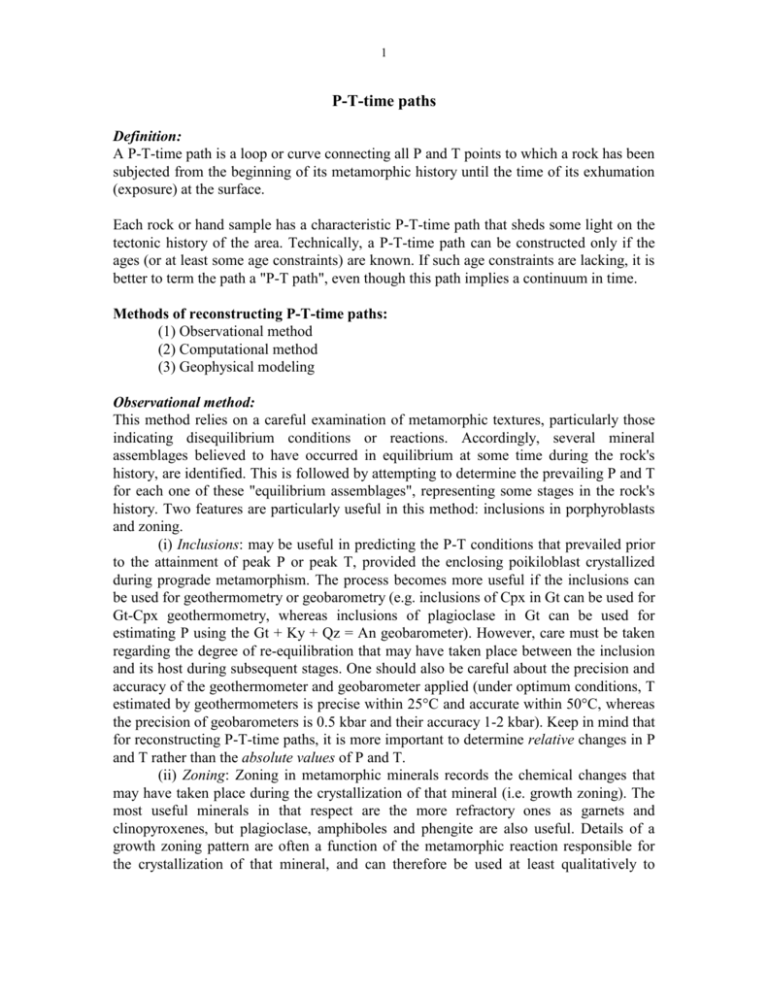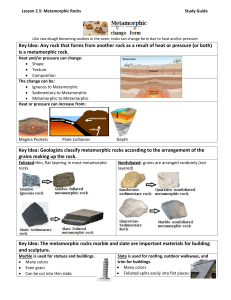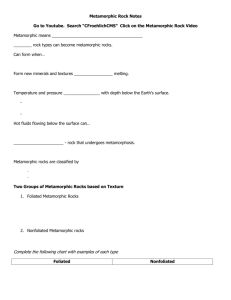P-T-time paths
advertisement

1 P-T-time paths Definition: A P-T-time path is a loop or curve connecting all P and T points to which a rock has been subjected from the beginning of its metamorphic history until the time of its exhumation (exposure) at the surface. Each rock or hand sample has a characteristic P-T-time path that sheds some light on the tectonic history of the area. Technically, a P-T-time path can be constructed only if the ages (or at least some age constraints) are known. If such age constraints are lacking, it is better to term the path a "P-T path", even though this path implies a continuum in time. Methods of reconstructing P-T-time paths: (1) Observational method (2) Computational method (3) Geophysical modeling Observational method: This method relies on a careful examination of metamorphic textures, particularly those indicating disequilibrium conditions or reactions. Accordingly, several mineral assemblages believed to have occurred in equilibrium at some time during the rock's history, are identified. This is followed by attempting to determine the prevailing P and T for each one of these "equilibrium assemblages", representing some stages in the rock's history. Two features are particularly useful in this method: inclusions in porphyroblasts and zoning. (i) Inclusions: may be useful in predicting the P-T conditions that prevailed prior to the attainment of peak P or peak T, provided the enclosing poikiloblast crystallized during prograde metamorphism. The process becomes more useful if the inclusions can be used for geothermometry or geobarometry (e.g. inclusions of Cpx in Gt can be used for Gt-Cpx geothermometry, whereas inclusions of plagioclase in Gt can be used for estimating P using the Gt + Ky + Qz = An geobarometer). However, care must be taken regarding the degree of re-equilibration that may have taken place between the inclusion and its host during subsequent stages. One should also be careful about the precision and accuracy of the geothermometer and geobarometer applied (under optimum conditions, T estimated by geothermometers is precise within 25°C and accurate within 50°C, whereas the precision of geobarometers is 0.5 kbar and their accuracy 1-2 kbar). Keep in mind that for reconstructing P-T-time paths, it is more important to determine relative changes in P and T rather than the absolute values of P and T. (ii) Zoning: Zoning in metamorphic minerals records the chemical changes that may have taken place during the crystallization of that mineral (i.e. growth zoning). The most useful minerals in that respect are the more refractory ones as garnets and clinopyroxenes, but plagioclase, amphiboles and phengite are also useful. Details of a growth zoning pattern are often a function of the metamorphic reaction responsible for the crystallization of that mineral, and can therefore be used at least qualitatively to 2 monitor changes in P-T conditions that may have prevailed during the crystallization of that mineral. Computational method: This method, which is also known as the "Gibbs method" was first applied by Spear and Selverstone (1983). It relies on the application of "differential thermodynamics" for solving a series of equations for such variables as P, T, and changes in mineral modes (M) after defining the system in terms of the number of components and number of phases, and identifying a set of net transfer and exchange reactions that occurred during the rock's history. This method therefore requires: (1) knowledge of the reactions that took place during metamorphism, (2) the occurrence of at least one zoned mineral in the sample studied, and (3) knowledge of the thermodynamic data for all the minerals concerned. Figs. 1b & 2 show examples of the application of this method for the calculation of P-T paths. Geophysical modeling: This method models the thickening and thinning of the crust coupled with heat generation, and requires knowledge of the thermal conductivity and diffusivity of the rocks. To understand this method, we must understand clearly the differences between the "geotherm" and the "metamorphic field gradient", and their relationships to the P-T paths of the rocks of the area investigated (Fig. 3). A geotherm is the change in T with depth for an area at given instant in time. A geothermal gradient is the slope of the geotherm. A metamorphic field gradient is simply a trajectory that joins all peak metamorphic temperatures reached by rocks from different metamorphic zones. As such, it has very little physical meaning! The disadvantage of geophysical modeling is that it neglects (or simplifies) the role of fluids in heat transfer, and the effects of magmas on the P-T paths, particularly as heat sources or heat sinks. England and Thompson (1984) were among the first to apply geophysical modeling to metamorphic petrology. Since then, several papers have been published on the subject, most notably those of Peacock (1987 and 1988), and short course notes on the subject were prepared by Spear and Peacock (1989). Figures 4, 5 and 6 show examples of the famous "sawtooth model" for crustal thickening by thrusting. Geophysical modeling has led to some important results which include: (1) Temperatures > 800°C cannot be attained by thrusting alone, and require an additional heat source such as magmas. (2) In thrust sheets, the upper and lower plates have different P-T-time paths. (3) The duration of a regional metamorphic event is in the order of tens of millions of years (much longer than a contact metamorphic event which is about 10,000 years). (4) In a thrust situation, the lower plate evolves through a "clockwise" P-T path (e.g. Fig. 8; in which the P axis is "upside down") in which peak pressures are attained prior to peak temperatures. This is simply because rocks are poor conductors of heat, taking a longer time to heat up compared to the duration of burial. (5) Rapidly uplifted terrains are characterized by high heat flow; rocks lose heat at a slower rate than that of their uplift. 3 (6) Most of the time spent by a rock during metamorphism is spent close to the peak temperature. This explains why "peak" metamorphic assemblages are often equilibrium assemblages. This is also a function of the time necessary for a transient geotherm to reach steady state conditions (e.g. Fig. 4). (7) Underthrusting of cold sediments produces an inverted metamorphic gradient, which may be erased if steady state geothermal conditions are to prevail long enough (Fig. 4). Types of P-T-time paths and their tectonic significance (1) Clockwise P-T paths: characteristic of collisional belts, areas of thrusting and subduction zones (Fig. 8). (2) Counterclockwise P-T-time paths: characteristic of areas of burial of continental crust that is already hot (e.g. continental crust thinned by extension and igneous intrusion; curve E, Fig. 9).








